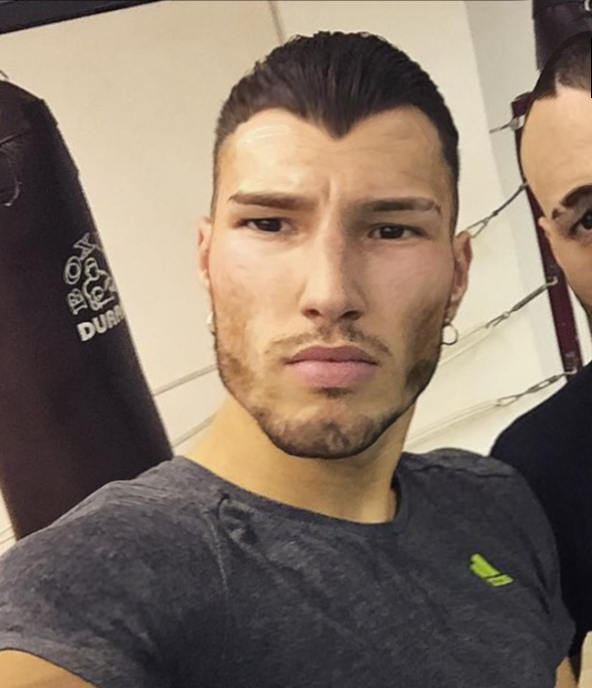Looksmaxers talk a lot about the importance of forward-grown, low-set brow ridges. Supraorbitals are important, but lateral orbitals are often overlooked. What’s ideal isn’t just a bar of bone above the eyes; you actually need a rectangular rim of bone surrounding the whole eye area for a striking high-T masculine look.
Exhibit A:


The first image is the original; the second image is my edit. The man in the middle looks way better with the defined lateral orbital rim in the original photo. Removing it makes his eye area look worse and less masculine.
Exhibit B:


Lighting affects how pronounced the lateral orbital rims appear. With the first photo’s lighting, David Pakman’s temple is highlighted, accentuating the bonemog of his lateral orbital rim. With the second photo’s lighting, his lateral orbital rims are nowhere to be seen, and he looks like a beta cuck rather than a high-T masc man.
Does the fact that lighting plays a role mean that the bone doesn’t matter? No, bone structure matters. If your eye area’s bone structure is good, your orbital rims can mog under some lighting conditions. If your eye area’s bone structure is bad, your eyes look boneless in all lighting.
Exhibit C:


Dwayne Johnson, one of the most masculine-looking men in the world, has pronounced lateral orbital rims that enhance his masculine appearance.
Exhibit D:



The first image is the original photo; the second image is my edit. Jordan Barrett doesn’t have pronounced lateral orbital rims. In the morph (not the best edit but it gets the point across), the prominent bone structure around his eye area makes for a harder, more forceful mog.
The Lateral Orbital Breadth to Cranial Breadth Ratio
What do you need in order to get a mogger rim of bone around the sides of your eye orbits? You need horizontally wide orbits and a skull that’s relatively narrow behind the orbital rims.
Exhibit E:

Jack Ma’s skull is too wide for mogger orbital rims. The skull behind the eye orbits being very wide takes away from the angularity of the lateral orbital contour. In other words, his lateral orbital rims smoothly transition into the sides of his face rather than looking like sharp edges.
Exhibit F:



Which of these 3 skulls has defined, angular orbital rims when there’s skin over the bones? The first 2. They have eye sockets that are horizontally wide and craniums that are relatively narrow, especially behind the orbits.
Exhibit A:


The first image is the original; the second image is my edit. The man in the middle looks way better with the defined lateral orbital rim in the original photo. Removing it makes his eye area look worse and less masculine.
Exhibit B:


Lighting affects how pronounced the lateral orbital rims appear. With the first photo’s lighting, David Pakman’s temple is highlighted, accentuating the bonemog of his lateral orbital rim. With the second photo’s lighting, his lateral orbital rims are nowhere to be seen, and he looks like a beta cuck rather than a high-T masc man.
Does the fact that lighting plays a role mean that the bone doesn’t matter? No, bone structure matters. If your eye area’s bone structure is good, your orbital rims can mog under some lighting conditions. If your eye area’s bone structure is bad, your eyes look boneless in all lighting.
Exhibit C:


Dwayne Johnson, one of the most masculine-looking men in the world, has pronounced lateral orbital rims that enhance his masculine appearance.
Exhibit D:



The first image is the original photo; the second image is my edit. Jordan Barrett doesn’t have pronounced lateral orbital rims. In the morph (not the best edit but it gets the point across), the prominent bone structure around his eye area makes for a harder, more forceful mog.
The Lateral Orbital Breadth to Cranial Breadth Ratio
What do you need in order to get a mogger rim of bone around the sides of your eye orbits? You need horizontally wide orbits and a skull that’s relatively narrow behind the orbital rims.
Exhibit E:

Jack Ma’s skull is too wide for mogger orbital rims. The skull behind the eye orbits being very wide takes away from the angularity of the lateral orbital contour. In other words, his lateral orbital rims smoothly transition into the sides of his face rather than looking like sharp edges.
Exhibit F:



Which of these 3 skulls has defined, angular orbital rims when there’s skin over the bones? The first 2. They have eye sockets that are horizontally wide and craniums that are relatively narrow, especially behind the orbits.












